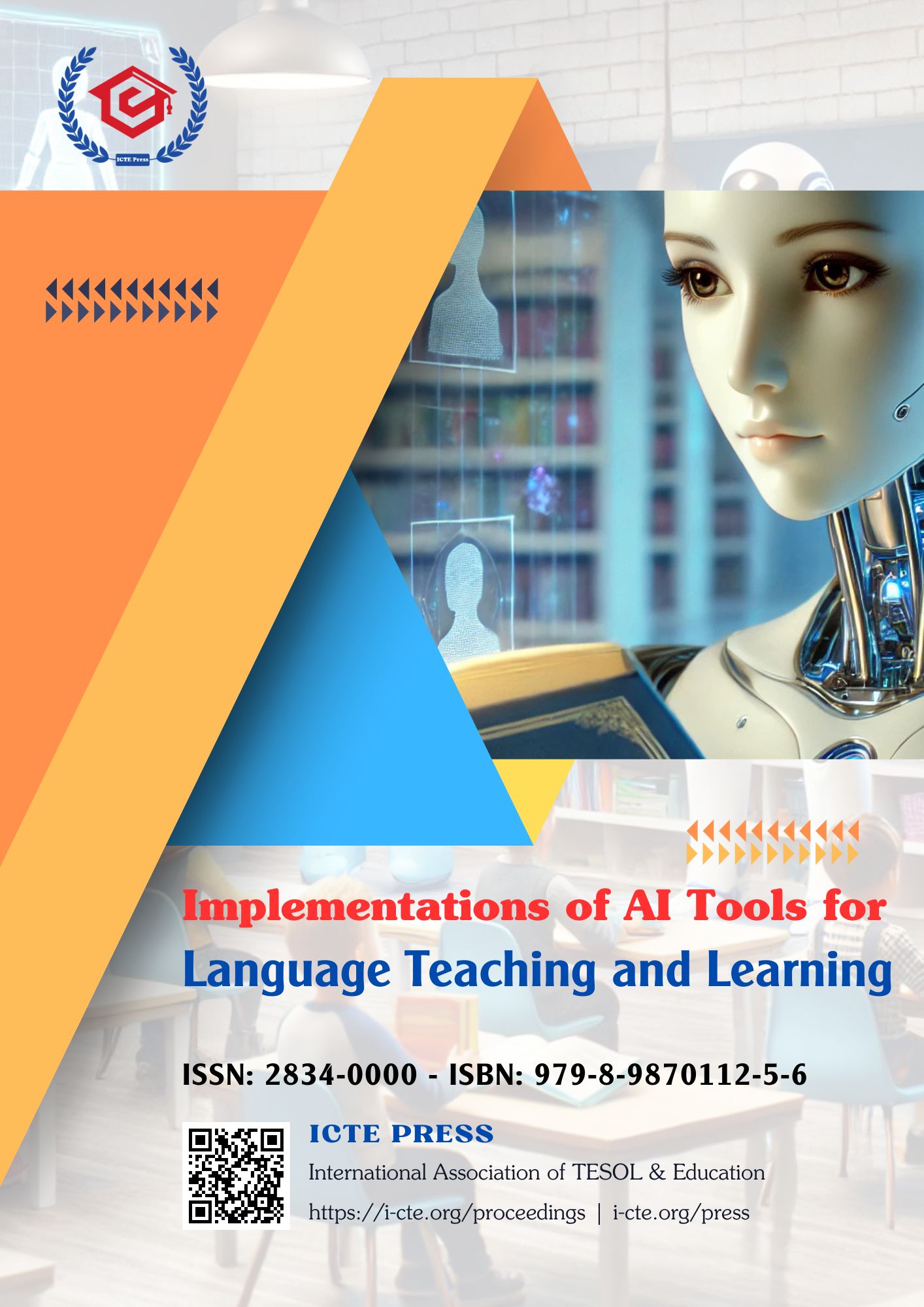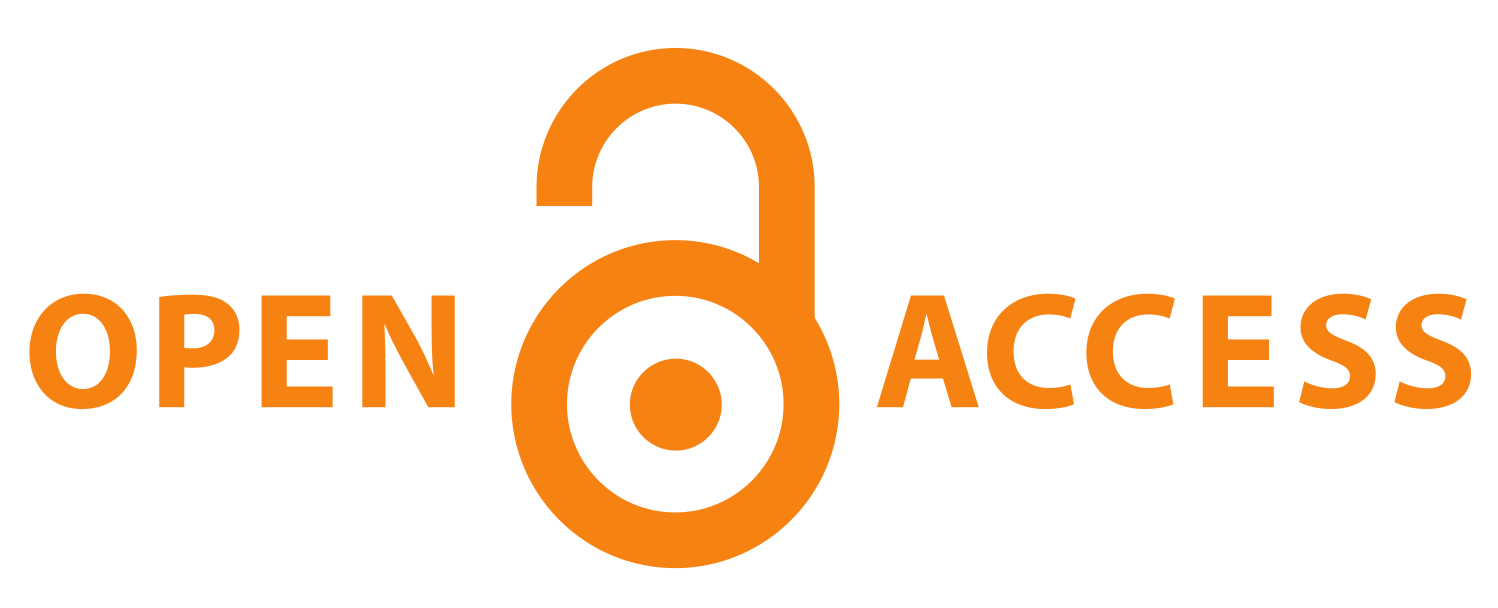Vocabulary Acquisition based on Personal Learning Pace
DOI:
https://doi.org/10.54855/ictep.24514Keywords:
Vocabulary enhancement, English vocabulary, Flippity, non-English majorsAbstract
The quasi-experimental study investigates the use of Flippity, an interactive online platform, to enhance vocabulary acquisition among 62 non-English major undergraduate students at Thai Nguyen University of Education. The research addresses a gap in the literature by focusing on the effectiveness of Flippity for Vocabulary learning at the undergraduate level. The study evaluates the impact of personalized, game-based learning on vocabulary retention through home-based practice. Results show significant improvements in the vocabulary proficiency of the experimental group using Flippity, demonstrating that the platform effectively supports vocabulary learning. These findings suggest that Flippity can be a valuable resource for educators, providing a flexible and engaging tool for improving vocabulary acquisition in home environments.References
Afify, M. K. (2020). Effect of interactive video length within e-learning environments on cognitive load, cognitive achievement and retention of learning. Turkish Online Journal of Distance Education, 21(4), 68-89. https://doi.org/10.17718/tojde.803360
Afrin, S. (2016). Writing problems of non-English major undergraduate students in Bangladesh: An observation. Open journal of social sciences, 4(3), 104-115. https://doi.org/http://dx.doi.org/10.4236/jss.2016.43016
Agca, R. K., & Özdemir, S. (2013). Foreign language vocabulary learning with mobile technologies. Procedia-Social and Behavioral Sciences, 83, 781-785. https://doi.org/10.1016/j.sbspro.2013.06.147
Al-Bashayreh, M., Almajali, D., Altamimi, A., et al. (2022). An empirical investigation of reasons influencing student acceptance and rejection of mobile learning apps usage. Sustainability, 14(7), 4325. https://doi.org/10.3390/su14074325
Alanezi, Y. H., & AlAzwani, N. S. (2020). Future of mobile learning during and after global (Covid-19) pandemic: college of basic education as case. Future, 11(17), 12. https://doi.org/https://doi.org/10.7176/jep%2F11-17-01
Alemi, M., Sarab, M. R. A., & Lari, Z. (2012). Successful learning of academic word list via MALL: Mobile Assisted Language Learning. International Education Studies, 5(6), 99-109. https://doi.org/10.5539/ies.v5n6p99
Altalhab, S. (2018). Short-and long-term effects of repetition strategies on vocabulary retention. Advances in Language and Literary Studies, 9(2), 146-149. https://doi.org/10.7575/aiac.alls.v.9n.2p.146
Ardito, G. (2020). Science at my own pace. In G. Ardito (Ed.), Curriculum, Instruction, and Assessment: Intersecting New Needs and New Approaches (pp. 55-78). Information Age Publishing.
Ashraf, T. A. (2015). Teaching vocabulary to non-English majors: A general perspective. DIU Journal of Humanities and Social Science, 2, 174-175. https://doi.org/10.36481/diujhss.v.02i1.tdcsgw42
Barreiro, A. V. S. (2022). Education 4.0 and its impact on the educational system during the pandemic and post pandemic Covid 19 in Ecuador. Sinergias educativas, 7(1), 121-122. https://doi.org/10.37954/se.v7i1.332
Bates, A. W. (2019). Teaching in a digital age: Guidelines for designing teaching and learning. BCcampus.
Borova, T., Chekhratova, O., Marchuk, A., et al. (2021). Fostering students’ responsibility and learner autonomy by using google educational tools. Revista Romaneasca pentru Educatie Multidimensionala, 13(3), 73-94. https://doi.org/10.18662/rrem/13.3/441
Carvalho, P. F., Sana, F., & Yan, V. X. (2020). Self-regulated spacing in a massive open online course is related to better learning. npj Science of Learning, 5(1), 2. https://doi.org/10.1038/s41539-020-0061-1
Chiang, H.-H. (2019). A Comparison between Teacher-Led and Online Text-to-Speech Dictation for Students' Vocabulary Performance. English Language Teaching, 12(3), 77-93. https://doi.org/10.5539/elt.v12n3p77
Christ, T., Wang, X. C., & Chiu, M. M. (2011). Using story dictation to support young children's vocabulary development: Outcomes and process. Early Childhood Research Quarterly, 26(1), 30-41. https://doi.org/10.1016/j.ecresq.2010.06.002
Christopher, T. (2022). Flippity–Supplementary Resources for the Classroom. 崇城大学 SILC 紀要, 2, 46-54.
Chuah, P., & Lim, P. (2018). Applying quality tools to improve student retention supporting process: a case study from WOU. Asian Association of Open Universities Journal, 13(1), 60-72. https://doi.org/10.1108/AAOUJ-01-2018-0003
Chung, C. E., Yasinin, N. F., Arsat, N. N., et al. (2021). A Study of Vocabulary Learning Strategies Among University Students from Non-English Majors. Open Educational Resources, 1-17.
Compeau, D. R., & Higgins, C. A. (1995). Computer self-efficacy: Development of a measure and initial test. MIS quarterly, 19(2), 189-211. https://doi.org/10.2307/249688
Criollo-C, S., Guerrero-Arias, A., Jaramillo-Alcázar, Á., & Luján-Mora, S. (2021). Mobile Learning Technologies for Education: Benefits and Pending Issues. Applied Sciences, 11(9), 4111. https://doi.org/10.3390/app11094111
Criollo-C, S., Lema, M., Gonzalez, M. S., et al. (2021). Exploring the technological acceptance of a mobile learning tool used in the teaching of an indigenous language. PeerJ Computer Science, 7. https://doi.org/10.7717/peerj-cs.550
Davis, F. D. (1989). Perceived usefulness, perceived ease of use, and user acceptance of information technology. MIS quarterly, 13(3), 319-340. https://doi.org/10.2307/249008
Deris, F., & Shukor, N. (2019). Vocabulary learning through mobile apps: A phenomenological inquiry of student acceptance and desired apps features. International Journal of Interactive Mobile Technologies (iJIM), 13(7), 129–140. https://doi.org/10.3991/ijim.v13i07.10845
Dixson, M. D. (2010). Creating effective student engagement in online courses: What do students find engaging? Journal of the Scholarship of Teaching and Learning, 10(2), 1-13.
Duckworth, A. L., Kirby, T. A., Tsukayama, E., et al. (2011). Deliberate practice spells success: Why grittier competitors triumph at the National Spelling Bee. Social psychological and personality science, 2(2), 174-181. https://doi.org/10.1177/1948550610385872
Ehri, L. C., & Rosenthal, J. (2007). Spellings of words: A neglected facilitator of vocabulary learning. Journal of Literacy Research, 39(4), 389-409. https://doi.org/10.1080/10862960701675341
Ellis, R. (2015). Understanding Second Language Acquisition 2nd Edition. Oxford University Press.
Faraj, A. K. A. (2015). Effective Strategies for Turning Receptive Vocabulary into Productive Vocabulary in EFL Context. Journal of Education and Practice, 6(27), 10-19.
Fatkhul, A., & Rahmawati, S. (2022). Improving students’ vocabulary through dictation method. Undergraduate Conference on Applied Linguistics, Linguistics, and Literature,
García Botero, G., Questier, F., Cincinnato, S., et al. (2018). Acceptance and usage of mobile assisted language learning by higher education students. Journal of Computing in Higher Education, 30, 426-451. https://doi.org/10.1007/s12528-018-9177-1
Georgiadou, E., & Siakas, K. V. (2006). Distance learning: technologies; enabling learning at own place, own pace, own time. Proceedings of the 11th International Conference on Software Process Improvement - Research into Education and Training, Southampton, UK.
Geschwind, L., Broström, A., & Larsen, K. (2020). Technical Universities: Past, present and future. Springer Nature.
Giyatmi, G. (2021). Optimizing Google classroom in online learning during Covid-19 Pandemic. The 4th International Coneference on Linguistics and Language Teaching, Depok, Indonesia.
Guay, F., Lessard, V., & Dubois, P. (2016). How can we create better learning contexts for children? Promoting students’ autonomous motivation as a way to foster enhanced educational outcomes. In Building autonomous learners: Perspectives from research and practice using self-determination theory (pp. 83-106). Springer.
Hampel, R. (2015). Developing online language teaching: Research-based pedagogies and reflective practices. Springer.
Hao, T., Wang, Z., & Ardasheva, Y. (2021). Technology-assisted vocabulary learning for EFL learners: A meta-analysis. Journal of Research on Educational Effectiveness, 14(3), 645-667. https://doi.org/10.1080/19345747.2021.1917028
Henriques, S., Correia, J. D., & Dias-Trindade, S. (2021). Portuguese primary and secondary education in times of covid-19 pandemic: An exploratory study on teacher training and challenges. Education Sciences, 11(9), 542. https://doi.org/10.3390/educsci11090542
Hidalgo, F. J. P. (2020). TELL, CALL, and MALL: Approaches to bridge the language gap. In International approaches to bridging the language gap (pp. 118-134). IGI Global.
Howard, J. M., & Scott, A. (2017). Any time, any place, flexible pace: Technology-enhanced language learning in a teacher education programme. Australian Journal of Teacher Education (Online), 42(6), 51-68. https://doi.org/10.14221/ajte.2017v42n6.4
Hsueh-Chao, M. H., & Nation, P. (2000). Unknown vocabulary density and reading comprehension. Reading in a Foreign Language, 13(1), 403–430. https://nflrc.hawaii.edu/rfl/item/43
Hughes, J., Dummett, P., & Stephenson, H. (2023). Life: A2-B1 (Vietnam 2 ed.). Cengage Learning.
Hwang, W.-Y., Huang, Y.-M., Shadiev, R., et al. (2014). Effects of using mobile devices on English listening diversity and speaking for EFL elementary students. Australasian journal of educational technology, 30(5). https://doi.org/doi.org/10.14742/ajet.237
Ilgaz, H. (2019). Adult Learners' Participation in a Blended Learning Environment: A Case Study on Imposed Pace Learning. Malaysian online journal of educational technology, 7(4), 15-29. https://doi.org/10.17220/mojet.2019.04.002
Jenks, C. J. (2023). New Frontiers in Language and Technology. Cambridge University Press.
Jiang, B., Gu, M., & Du, Y. (2023). Recent advances in intelligent textbooks for better learning. Learning: Designing the Future, 247-261. https://doi.org/10.1007/978-3-031-09687-7_15
Kashefian-Naeeini, S., & Kouhpeyma, Y. (2020). Fostering learner autonomy in educational settings. International Journal of Multicultural and Multireligious Understanding, 7(7), 190-201. https://doi.org/10.18415/ijmmu.v7i7.1765
Kazazoğlu, S. (2013). Dictation as a language learning tool. Procedia-Social and Behavioral Sciences, 70, 1338-1346. https://doi.org/10.1016/j.sbspro.2013.01.195
Khan, A. A., & Madden, J. (2016). Speed learning: maximizing student learning and engagement in a limited amount of time. International Journal of Modern Education and Computer Science, 8(7), 22-30. https://doi.org/10.5815/ijmecs.2016.07.03
Kilickaya, F., & Krajka, J. (2010). Teachers' Technology Use in Vocabulary Teaching. Online Submission.
Klimova, B., & Polakova, P. (2020). Students’ perceptions of an EFL vocabulary learning mobile application. Education Sciences, 10(2), 37. https://doi.org/10.3390/educsci10020037
LaFond, L. L. (2023). A Distracted Learning Pandemic: The Aftermath of Synchronous Online Courses. Technology-Enhanced Language Teaching and Learning: Lessons from the Covid-19 Pandemic, 13. https://doi.org/10.5040/9781350271043.ch-002
Lan, Y.-J. (2013). The effect of technology-supported co-sharing on L2 vocabulary strategy development. Journal of Educational Technology & Society, 16(4), 1-16.
Laufer, B. (1990). Ease and difficulty in vocabulary learning: Some teaching implications. Foreign Language Annals, 23(2), 147-155. https://doi.org/10.1111/j.1944-9720.1990.tb00355.x
Le, T. T. K., & Tran, B. T. (2022). Using Zalo application as a learning management system. Proceedings of the 8th International Conference on Frontiers of Educational Technologies, Ho Chi Minh.
Lee, S. H., & Muncie, J. (2006). From receptive to productive: Improving ESL learners' use of vocabulary in a postreading composition task. TESOL quarterly, 40(2), 295-320. https://doi.org/10.2307/40264524
Li, S., Hao, D., Liu, B., et al. (2021). Evaluation of eyestrain with vertical electrooculogram. Computer Methods and Programs in Biomedicine, 208, 106171. https://doi.org/10.2307/40264524
Li, Y., Li, Y., Zhang, M., et al. (2024). CB-Whisper: Contextual Biasing Whisper Using Open-Vocabulary Keyword-Spotting. Proceedings of the 2024 Joint International Conference on Computational Linguistics, Language Resources and Evaluation, Torino, Italia.
Looyestyn, J., Kernot, J., Boshoff, K., et al. (2017). Does gamification increase engagement with online programs? A systematic review. PloS one, 12(3), e0173403. https://doi.org/10.1371/journal.pone.0173403
Lu, M. (2008). Effectiveness of vocabulary learning via mobile phone. Journal of computer assisted learning, 24(6), 515-525. https://doi.org/10.1111/j.1365-2729.2008.00289.x
Mayasari, W. J. (2018). The use of spelling bee game to increase the students’ vocabulary mastery of the seventh grade at smpn i bantan. Inovish Journal, 3(2), 129-136. https://doi.org/10.35314/inovish.v3i2.828
Min, Y.-K. (2013). Vocabulary acquisition: Practical strategies for ESL students. Journal of International students, 3(1), 64-69. https://doi.org/10.32674/jis.v3i1.520
Miyazoe, T., & Anderson, T. (2010). Learning outcomes and students' perceptions of online writing: Simultaneous implementation of a forum, blog, and wiki in an EFL blended learning setting. System, 38(2), 185-199. https://doi.org/10.1016/j.system.2010.03.006
Mojarad, S., Essa, A., Mojarad, S., & Baker, R. S. (2018). Data-driven learner profiling based on clustering student behaviors: learning consistency, pace and effort. Intelligent Tutoring Systems: 14th International Conference, Montreal, QC, Canada.
Moore, M. G. (1972). Learner autonomy: The second dimension of independent learning. Convergence, 5(2), 76.
Mpungose, C. B., & Khoza, S. B. (2022). Postgraduate students’ experiences on the use of Moodle and Canvas learning management system. Technology, Knowledge and Learning, 27(1), 1-16. https://doi.org/10.1007/s10758-020-09475-1
Musa, A. H. (2019). The Relationship between Mastering Dictation and University Students' Achievement of Spelling Vocabulary and Writing Text. Journal of Language Studies, 2(2), 182-122. https://doi.org/10.25130/jls.2.2.11
Nafisah, A., Anwar, C., Hartono, H., & Permatasari, R. (2022). The Impact of Chinese Whisper Game towards EFL Young Learners Vocabulary Mastery. Journal of Advanced Multidisciplinary Research, 3(2), 79-92. https://doi.org/10.30659/jamr.3.2.79-92
Naidu, S. (2008). Enabling time, pace, and place independence. In Handbook of research on educational communications and technology (pp. 259-268). Routledge.
Nation, I. S. P. (1990). Teaching and Learning Vocabulary. Newbury House Publishers.
Nation, I. S. P. (2006). How large a vocabulary is needed for reading and listening? Canadian modern language review, 63(1), 59-81. https://doi.org/10.1353/cml.2006.0049
Nation, I. S. P. (2013). Learning Vocabulary in Another Language. Cambridge University Press.
Ndraha, V. E., & Kurniawan, M. (2019). Playing" CABE"(Searching and Whispering) to Increase Children’s English Vocabulary. Jurnal Pendidikan Usia Dini, 13(1), 143-157. https://doi.org/10.21009/10.21009/JPUD.131.11
Ngan, N. T. T. (2021). An investigation of vocabulary learning strategies used by non-English majors at Hong Duc university. Journal of Science, 7, 113. https://vjol.info.vn/index.php/HDU/article/view/68060
Ngo, T. C. T. (2023). EFL Students' Strategies for Learning Academic Vocabulary with Mobile Phones at Van Lang University in Vietnam. International Journal of Language Instruction, 2(4), 19-42. https://doi.org/10.54855/ijli.23242
Nunan, D. (2003). Practical English language teaching (International ed.). McGraw-Hill.
Paine, N. (2019). Workplace Learning: How to Build a Culture of Continuous Employee Development. Kogan Page.
Pauk, W., & Owens, R. J. Q. (2010). How to study in college (10th Ed. ed.). Cengage Learning.
Pindeh, N., Suki, N. M., & Suki, N. M. (2016). User acceptance on mobile apps as an effective medium to learn Kadazandusun language. Procedia Economics and Finance, 37, 372-378. https://doi.org/10.1016/S2212-5671(16)30139-3
Rahimi, M. (2008). Using dictation to improve language proficiency. Asian EFL Journal, 10(1), 33-47. https://asian-efl-journal.com/March_2008_EBook.pdf
Reinders, H. (2020). Fostering autonomy: helping learners take control. English Teaching, 75(2), 135-147. https://doi.org/10.15858/engtea.75.2.202006.135
Renandya, W. A., & Widodo, H. P. (2016). English Language Teaching Today: Linking Theory and Practice. Springer International Publishing.
Revadekar, A., Oak, S., Gadekar, A., & Bide, P. (2020). Gauging attention of students in an e-learning environment. 2020 IEEE 4th Conference on Information & Communication Technology, Chennai, India.
Rohmawati, A. (2015). Spelling bee in teaching vocabulary. Journal of English and Education, 3(2), 1-15.
Salas‐Pilco, S. Z., Yang, Y., & Zhang, Z. (2022). Student engagement in online learning in Latin American higher education during the COVID‐19 pandemic: A systematic review. British Journal of Educational Technology, 53(3), 593-619. https://doi.org/10.1111/bjet.13190
Santiana, S., Silvani, D., & Ruslan, R. (2021). Optimizing LMS CANVAS for interactive online learning perceived by the students. Journal of English Education and Teaching, 5(4), 529-543. https://doi.org/10.33369/jeet.5.4.529-543
Sasi, S., Kayimbasioglu, D., Aksal, A., et al. (2017). Learning English language in peace context through technology. Eurasia J. Math. Sci. Technol. Educ., 13(6), 605-1614.
Scrivener, J. (2005). Learning teaching (Vol. 2). Macmillan Oxford.
Sekarini, R. (2013). Implementing spelling bee game through three phase technique to improve the seventh graders' spelling ability Universitas Negeri Malang.
Serag, A. (2011). Teaching English writing skills: developing learner autonomy in the Japanese context. International Journal of Arts & Sciences, 4(10), 223.
Sivalingam, N. (2022). Learning at Speed: How to Upskill and Reskill Your Workforce at Pace to Drive Business Performance. Kogan Page.
Stickler, U., & Hampel, R. (2015). Transforming teaching: New skills for online language learning spaces. In Developing online language teaching: Research-based pedagogies and reflective practices (pp. 63-77). Springer.
Stickler, U., Hampel, R., & Emke, M. (2020). A developmental framework for online language teaching skills. Australian Journal of Applied Linguistics, 3(1), 133-151. https://doi.org/10.29140/ajal.v3n1.271
Sturt, M. (1921). A comparison of speed with accuracy in the learning process. British Journal of Psychology, 12(3), 289. https://doi.org/10.29140/ajal.v3n1.271
Sunawan, S., Amin, Z. N., Hafina, A., & Kholili, M. (2021). The differences of students’ burnout from level of education and duration daily online learning during COVID-19 pandemics. Proceedings of the International Conference on Industrial Engineering and Operations Management, Singapore.
Surkamp, C., & Viebrock, B. (2018). Teaching English as a Foreign Language. Springer.
Tetty, M. (2022). Stimulating English Speaking Fluency for Young Learners through Gamific Flippity. Proceedings of the 4th International Conference on Innovation in Education, Science and Culture, Medan, Indonesia.
Thanh, P. T. N., Thông, N. N., & Thảo, N. T. P. (2020). Cảm nhận của sinh viên chính quy khi trải nghiệm học trực tuyến hoàn toàn trong thời gian phòng chống dịch Covid-19. Tạp chí Khoa học Đại học Mở Thành phố Hồ Chí Minh, 15(2), 22-27.
Thomas, P. Y. (2011). Cloud computing: A potential paradigm for practising the scholarship of teaching and learning. The electronic library, 29(2), 214-224. https://doi.org/10.1108/02640471111125177
Trang, T. T. T. (2021). How can learners study at their own pace and improve their autonomy? International Journal of Innovation and Applied Studies, 33(4), 618-624.
Trčková, K., Maršálek, R., & Polášková, S. (2022). Virtual Didactic Game in Teaching Chemistry. EDULEARN22 Proceedings, Palma, Spain.
Trinh, N. B., & Pham, D. T. T. (2021). Challenges in speaking classrooms among non-English majors. Vietnam journal of education, 5(2), 37-42. https://doi.org/10.52296/vje.2021.52
Tullis, J. G., & Benjamin, A. S. (2011). On the effectiveness of self-paced learning. Journal of memory and language, 64(2), 109-118. https://doi.org/10.1016/j.jml.2010.11.002
Ur, P. (2012). A Course in English Language Teaching. Cambridge University Press.
Utami, P. (2018). The Influence Of Using Chinese Whisper Game Towards Students’ speaking Ability At The First Semester Of The Eighth Grade In Smp Negeri 1 Tanjungsari South Lampung 2017/2018 Academic Year State Islamic University.
Vo, T., Truong, D., & Nguyen, P. (2023). The impact of digital technology on content and language integrated learning in higher education: a systematic review of literature. ICTE Conference Proceedings, Ho Chi Minh, Vietnam.
Wang, A. Y. (1983). Individual differences in learning speed. Journal of Experimental Psychology: Learning, Memory, and Cognition, 9(2), 300. https://doi.org//10.1037/0278-7393.9.2.300
Wang, D. (2021). Strategies for Non-English majors in china to improve their English vocabulary University of Wisconsin-Platteville
Webb, S., & Macalister, J. (2013). Is text written for children useful for L2 extensive reading? TESOL quarterly, 47(2), 300-322. https://doi.org/10.1002/tesq.70
Wiggins, G., & McTighe, J. (2005). Backward Design. In Understanding by design (pp. 13-34). Ascd.
Wong, C. H. T., & Yunus, M. M. (2023). Let" Flippity" Speak: Using Online Board Game to Improve Speaking Skills Among Elementary Pupils. European Journal of Educational Research, 12(2), 1085-1096. https://doi.org/10.12973/eu-jer.12.2.1085
Yaman, İ., & Ekmekçi, E. (2016). A shift from CALL to MALL? Participatory Educational Research, 4(2), 25-32.
Yan, S. (2011). A study on English vocabulary strategies used by non-English majors University of Wisconsin-Platteville.
Yannier, N., Hudson, S. E., Koedinger, K. R., et al. (2021). Active learning:“Hands-on” meets “minds-on”. Science, 374(6563), 26-30. https://doi.org/10.1126/science.abj9957
Yen, T., Khue, N., & Trang, N. (2023). Using the Jigsaw Technique to Improve English Speaking Skills for Freshmen. International Journal of Research and Review, 10(5), 367-382. https://doi.org/10.52403/ijrr.20230544
Yu, K., Tan, L., Mumtaz, S., et al. (2021). Securing critical infrastructures: deep-learning-based threat detection in IIoT. IEEE Communications Magazine, 59(10), 76-82. https://doi.org/10.1109/MCOM.101.2001126
Yusuf, Y. Q., Mustafa, F., & Alqinda, M. (2017). The use of spelling bee game in teaching vocabulary to junior high school students. Proceedings of The 1st National Conference on Teachers' Professional Development, Syiah Kuala University, Banda Aceh, Indonesia.
Zhi-Liang, L. (2010). A Study on English Vocabulary Learning Strategies for Non-English Majors in Independent College/Etude Sur Les Stratégies De L'apprentissage De Vocabulaire Anglais Pour Les Étudiants Qui Ne Sont Pas Dans La Spécialité De La Langue Anglaise Dans Les Universités Indépendantes. Cross-cultural communication, 6(4), 152.
Zhu, J., Yuan, H., Zhang, Q., et al. (2022). The impact of short videos on student performance in an online-flipped college engineering course. Humanities and Social Sciences Communications, 9(1), 1-10. https://doi.org/10.1057/s41599-022-01355-6
Downloads
Published
How to Cite
Issue
Section
License
Copyright (c) 2024 Nguyen Nam Khanh, Tran Nam Phuong, Tran Thi Thu Hoai

This work is licensed under a Creative Commons Attribution 4.0 International License.
Authors retain copyright and grant the picte the right of first publication with the work simultaneously licensed under a Creative Commons Attribution 4.0 International License that allows others to share the work with an acknowledgment of the work's authorship and initial publication in this journal.
Authors are able to enter into separate, additional contractual arrangements for the non-exclusive distribution of the proceedings' published version of the work (e.g., post it to an institutional repository, in a journal, or publish it in a book), with an acknowledgment of its initial publication in this proceedings.
Authors are permitted and encouraged to post their work online (e.g., in institutional repositories or on their website) prior to and during the submission process.










